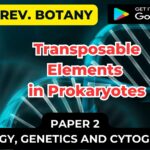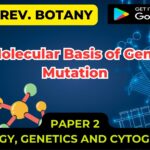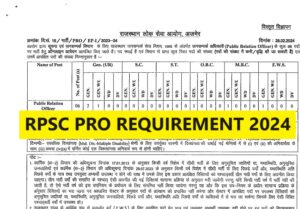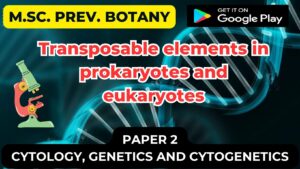Role of Induced Mutation in Crop Improvement:
- Induced mutations are useful in crop improvement in the following five principal ways:
1. In the development of improved varieties:
- More than 2000 improved varieties of field and horticultural crops with high yield, improved quality, earliness, resistance to biotic and abiotic stresses have been developed through induced mutations.
2. Induction of Male Sterility:
- The male sterility has been induced in many crops such as pearl millet which is used in hybrid seed production.
3. Production of Haploids:
- X-ray induced haploids have been developed in many crops which are used for development of pure lines after chromosomal doubling.
4. Creation of Genetic Variability:
- Induced mutations lead to creation of vast genetic variability in a population which provides basis for selection.
5. In some cases, induced mutations have been used for overcoming problem of self-incompatibility.
- Mechanisms of Spontaneous Mutation:
- It is known now that spontaneous mutations arise from a variety of sources.
- There are three important mechanisms of spontaneous mutations, viz:
(i) Errors in DNA replication,
(ii) Spontaneous lesions, and
(iii) Transposable genetic elements.
These are briefly discussed below:
1. Errors in DNA Replication:
- Mis-pairing in the course of replication is a source of spontaneous base substitution. (Mis-pairing was covered earlier in the discussion of 5-BU.)
- Most mis-pairing mutations are transitions.
- This is likely to be because an A . C or G . T mispair does not deform the DNA double helix as much as A . G or C . T base pairs do.
- However, transversions also can occur through mis-pairing. Replication errors can also lead to frame shift mutations.
2. Spontaneous Lesions:
- Naturally occurring damage to the DNA, called spontaneous lesions, also can generate mutations.
- The spontaneous lesions are of three types, viz:
(i) Depurination,
(ii) Deamination, and
(iii) Oxidatively damaged bases. The first one is more common.
(i) Depurination:
- As stated above, aflatoxin induces depurination. However, depurination also occurs spontaneously.
- A mammalian cell spontaneously loses about 10,000 purines from its DNA during a 20-hour cell generation period at 37°C.
- If these lesions persist, they will result in significant DNA damage because, during replication, the apurinic sites cannot specify any kind of base.
- However, under certain conditions, a base can be inserted across from an apurinic site, frequently resulting in a mutation.
(ii) Deamination:
- The deamination of cytosine yields uracil. Unrepaired uracil residues will pair with adenine in the course of replication, resulting in the conversion of a G-C pair into an AT pair (a G-C —> A-T transition).
- Deamination’s at certain cytosine positions have been found to be one type of mutational hot spot.
- DNA sequence analysis of hot spots for G-C A-T transitions in the lacl gene has shown that 5-methylcytosine residues are present at the position of each hot spot.
- Enzyme uracil-DNA glycosylase [one of the repair enzymes in the cell], recognizes the uracil residues in the DNA that arise from deamination’s and excises them, leaving a gap which is subsequently filled in.
- However, the deamination of 5-methylcytosine generates thymine (5-methyluracil), which is not recognized by the enzyme uracil-DNA glycosylase and is thus not repaired.
- Therefore, C —> T transitions generated by deamination are seen more frequently at 5-methylcytosine sites, because they escape this repair system.
(iii) Oxidatively damaged bases:
- This type of lesion by active oxygen species, such as superoxide radicals (02D), hydrogen peroxide (H202), and hydroxyl radicals (OHD), which are produced as by-products of normal aerobic metabolism.
- These oxygen species can cause oxidative damage to DNA, as well as to precursors of DNA (such as GTP), resulting in mutation. Such mutations have been implicated in a number of human diseases. Such product frequently mispairs with A, resulting in a high level of G —> T transversions.
3. Transposable Genetic Elements:
- Transposable elements are also reported to play important role in the induction of spontaneous mutations in various organisms.
- Biological Repair Mechanisms of Spontaneous Mutation:
- Living cells have evolved a series of enzymatic systems that repair DNA damage in a variety of ways.
- The low spontaneous mutation rate is indicative of the efficiency of these repair systems.
- Failure of these systems can lead to a higher mutation rate.
The DNA repair mechanisms can be divided in to four categories, viz:
(1) Prevention of errors,
(2) Reversal of damage,
(3) Excision repair, and
(iv) Post replication repair.
These are briefly discussed as follows:
1. Prevention of Errors:
- Some enzymatic systems neutralize potentially damaging compounds before they even react with DNA.
- One such system detoxifies superoxide radicals produced during oxidative damage to DNA.
- The enzyme superoxide dismutase catalyzes the conversion of the superoxide radicals into hydrogen peroxide, and the enzyme catalase, in turn, converts the hydrogen peroxide into water.
2. Direct Reversal of Damage:
- The most straight forward way to repair a lesion is to reverse it directly to the normal base.
- Reversal is not always possible, because some types of damage are essentially irreversible. In a few cases, however, lesions can be repaired in this way.
- One case is a mutagenic photodimer caused by UV light.
- The cyclobutane pyrimidine photodimer can be repaired by a photolyase that has been found in bacteria and lower eukaryotes but not in humans.
- The enzyme binds to the photodimer and splits it, in the presence of certain wavelengths of visible light, to generate the original bases.
- This enzyme cannot operate in the dark, so other repair pathways are required to remove UV damage.
- A photolyase that-revers the 6-4 photoproducts has also been detected in plants and Drosophila.
- Alkyl transferases are enzymes that directly reverse lesions.
- They remove certain alkyl groups that have been added to the 0-6 positions of guanine by such mutagens as nitrosoguanidine and ethyl methane sulfonate.
- The methyl transferase from E. coli has been well studied.
- This enzyme transfers the methyl group from 0-6-methyl-guanine to a cysteine residue on the protein.
- When this happens, the enzyme is inactivated, so this repair system can be saturated if the level of alkylation is high enough.
3. Excision-Repair Pathways:
- The general excision-repair system breaks a phosphodiester bond on either side of the lesion, on the same strand, resulting in the excision of an oligonucleotide.
- This leaves a gap that is filled by repair synthesis, and a ligase seals the breaks. In prokaryotes, 12 or 13 nucleotides are removed, whereas, in eukaryotes, from 27 to 29 nucleotides are eliminated.
- Certain lesions are too slight and cause a small distortion which cannot be recognized by the general excision-repair system and its counterparts in higher cells.
- Thus, additional specific excision pathways are necessary.
- Base-excision repair is carried out by DNA glycosylases that cleave N-glycosidic (base-sugar) bonds, thereby liberating the altered bases and generating apurinic or apyrimidinic sites (AP sites).
- The resulting site is then repaired by an AP site-specific endonuclease repair pathway.
- Numerous DNA glycosylases exist. One, uracil-DNA glycosylase, removes uracil from DNA. Uracil residues, which result from the spontaneous deamination of cytosine, can lead to a C —> T transition if unrepaired.
- It is possible that the natural pairing partner of adenine in DNA is thymine (5-methyluracil) rather than uracil so as to allow the recognition and excision of these uracil residues.
- If uracil were a normal constituent of DNA, such repair would not be possible.
- All cells have endonucleases that attack the sites left after the spontaneous loss of single purine or pyrimidine residues.
- The AP endonucleases are vital to the cell, because, spontaneous depurination is a relatively frequent event.
- These enzymes introduce chain breaks by cleaving the phosphodiester bonds at AP sites.
- This initiates an excision-repair process mediated by three further enzymes-an exonuclease, DNA polymerase I, and DNA. ligase.
- Owing to the efficiency of the AP endonuclease repair pathway, it can be the final step of other repair pathways.
- Thus, if damaged base pairs can be excised, leaving an AP site, the AP endonucleases can complete the restoration to the wild type.
- This is what happens in the DNA glycosylase repair pathway.
4. Post Replication Repair:
- Some repair pathways are capable of recognizing errors even after DNA has already undergone replication.
- One example, termed the mismatch-repair system, can detect such mismatches.
- Mismatch-repair systems have to do at least three things:
1. Recognize mismatched base pairs.
2. Determine which base in the mismatch is the incorrect one.
3. Excise the incorrect base and carry out repair synthesis.
- The second property is the crucial one of such a system. Once the mismatched site ‘has been identified, the mismatch-repair system corrects the error.
- Unless it is capable of discriminating between the correct and the incorrect bases, the mismatch repair system cannot determine which base to excise to prevent a mutation from arising.
- But replication errors produce mismatches on the newly synthesized strand, so it is the base on this strand that must be recognized and excised.






